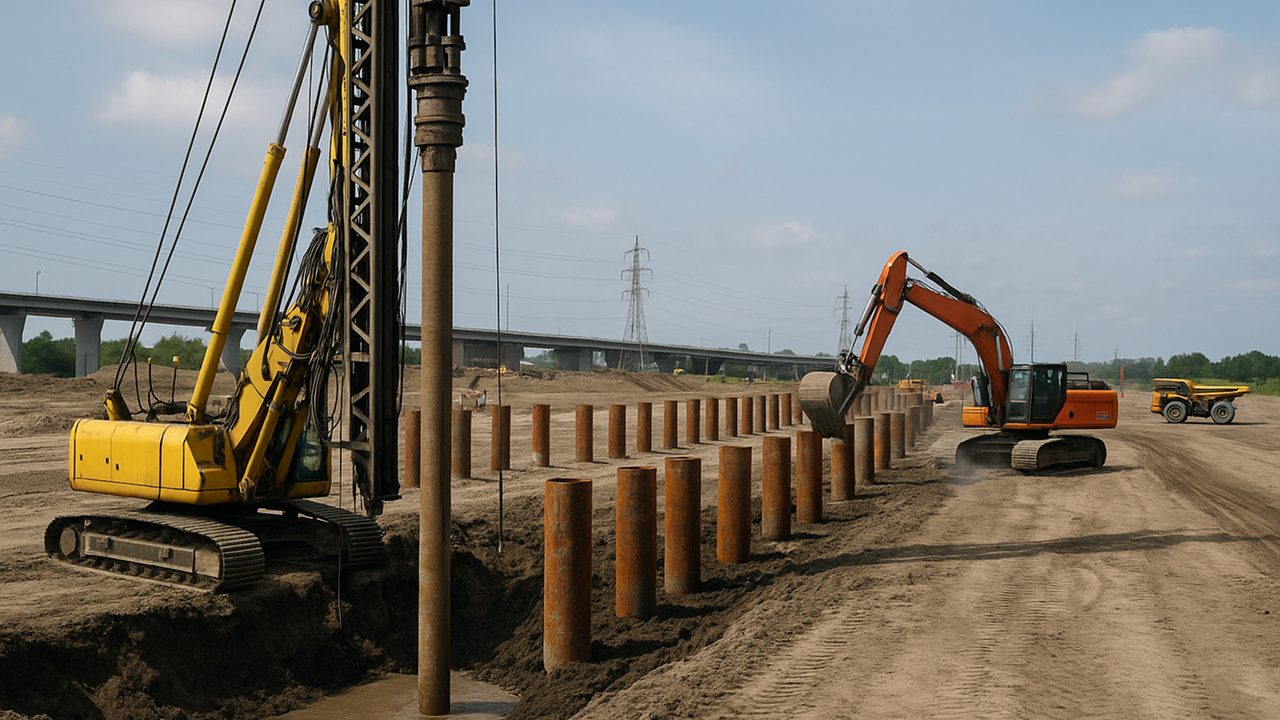What Are Micropiles? Design, Construction Techniques, and Application
What Are Micropiles?
So, what exactly is a micropile? Think of it as a small-diameter, deep foundation solution and micropile construction . Unlike their bulkier cousins—like traditional drilled shafts or driven piles—micropiles are typically less than 300 mm (about 12 inches) in diameter. They’re essentially a high-strength steel casing or reinforcing bar that’s drilled into the ground and then filled with a cement grout.
The magic of these drilled and grouted micropiles lies in their simplicity and incredible strength. Despite their small size, they can transfer significant loads to competent soil or rock layers far below the surface. This makes them ideal for sites with tricky soil conditions, limited access, or where minimal disturbance is required.
Design Principles: It’s All in the Details
Designing a micropile isn’t just about sticking a rod in the ground. It’s a sophisticated process that involves engineering precision to ensure they can handle the job. The design revolves around two key components: geotechnical capacity and structural capacity.
Geotechnical Capacity
This is all about how the micropile interacts with the surrounding soil. The load is transferred to the soil through two main mechanisms:
- Skin friction (friction between the grout and the soil)
- End-bearing (load supported by the pile tip)
Geotechnical engineers conduct rigorous soil investigations to determine the soil layers’ properties and how much load they can safely bear. This is crucial for defining the length and spacing of the micropiles.
Structural Capacity
This refers to the strength of the micropile itself. The internal steel element, whether a pipe or threaded bar, is designed to handle tension or compression loads. The cement grout contributes additional strength and stiffness, ensuring that the pile behaves as a single, solid unit. Think of the steel as the spine and the grout as the muscle, they work together to create superior load-bearing capacity enhancement.
Design must also ensure the overall stability of the structure. In foundation underpinning systems, a group of micropiles might be used to lift and stabilize an existing building. The design must accommodate the specific loads, soil conditions, and existing structure geometry for long-lasting results.
Micropiles Construction: The Art of Precision
Now, let’s get our hands dirty and explore micropiles construction—a process that’s both efficient and clean, making it ideal for urban environments.
Step 1: Drilling the Borehole
A small-diameter drill rig creates a borehole to the desired depth. This is where micropiles installation begins. These compact rigs can access tight spaces, making them ideal for city centers or inside existing buildings. The most common drilling method is rotary drilling, using a wash or air flush to remove soil cuttings.
Step 2: Inserting the Steel Element
Once the borehole is ready, a high-strength steel reinforcing bar or pipe is inserted—this is the core of the micropile and crucial for its structural integrity.
Step 3: Grouting
A high-strength cement-based grout is pumped into the borehole from the bottom up, filling the space around the steel and locking it in place. This forms a strong bond with the surrounding soil, maximizing skin friction and overall capacity.
This drilled and grouted micropiles method is minimally disruptive, quiet, and low in vibration—perfect for sensitive structures and residential areas.
The micropiles construction process is a true testament to modern engineering, combining minimal footprint with maximum performance.
Applications: Where Micropiles Shine Bright
So, where do you see micropiles in action? Pretty much everywhere! Their versatility makes them a top choice when traditional deep foundation solutions fall short.
- Foundation Underpinning Systems
Perhaps the most common use. When a building’s foundation is failing due to settlement or water table changes, micropiles can stabilize and strengthen it. They’re drilled through the existing foundation and into stable ground, creating a new, deeper support system without major demolition.
- Load-Bearing Capacity Enhancement
Need to support heavier loads? Whether you’re adding a new floor or installing heavy machinery, micropiles can boost the load capacity of an existing foundation.
- Slope Stabilization and Retaining Walls
Micropiles serve as anchors in soil stabilization techniques, forming a network of deep supports that hold slopes in place and prevent landslides or erosion. They are often used alongside shotcrete or ground anchors to reinforce retaining walls.
- Seismic Retrofitting
In earthquake-prone regions, micropiles improve a structure’s seismic resilience by anchoring the foundation to deeper, more stable strata. This makes buildings better equipped to resist shaking and lateral forces.
- New Construction in Difficult Conditions
Building on loose sand, soft clay, or contaminated soil? Micropiles construction allows you to bypass weak layers and anchor into competent strata, ensuring a safe and durable foundation.
The Economic and Environmental Edge
Beyond their technical prowess, another reason for the growing popularity of micropiles construction is their significant economic and environmental advantages. The smaller equipment required for micropiles installation means lower mobilization costs and a smaller carbon footprint compared to large, heavy machinery. Their ability to work in confined spaces reduces the need for expensive and disruptive site clearing and excavation. Furthermore, because they create minimal noise and vibration, they are ideal for sensitive urban sites, minimizing disruption to surrounding communities and infrastructure. This makes them a smarter, more sustainable choice for modern projects, aligning perfectly with the industry’s increasing focus on green construction practices and efficiency.
Final Thoughts: The Future of Deep Foundation Solutions
As construction challenges grow, micropiles construction remain at the forefront of innovation. Their ability to provide high-strength support in compact form makes them invaluable in modern projects.
From preserving historic landmarks to reinforcing high-rise towers, micropiles installation offers a clean, efficient, and powerful solution to today’s most complex foundation issues.
Sometimes the best deep foundation solutions come in small packages. With urban areas becoming denser and demands on infrastructure rising, micropiles construction are set to play an even greater role in shaping our cities’ futures.


Leave a Reply